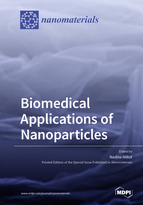Biomedical Applications of Nanoparticles
A special issue of Nanomaterials (ISSN 2079-4991).
Deadline for manuscript submissions: closed (10 January 2019) | Viewed by 109269
Special Issue Editor
Interests: nanomaterials; nanoscale physicochemical properties; characterisation techniques; superparamagnetic iron oxide nanoparticles; titanate nanotubes and nanoribbons; soft chemistry; hydrothermal synthesis; nanohybrids; functionalization; biomedical applications; toxicity
Special Issues, Collections and Topics in MDPI journals
Special Issue Information
Dear Colleagues,
The concept of nanomaterials that can be designed and administered for the human body to improve health is of great interest. During the past few years, there has been an increasing amount of research on the use of nanomaterials in diverse areas of biomedical research, including biological sensing, labelling, imaging, cell separation and therapy. Nano-objects are associated with organic molecules to vectorize drugs. The objective is then to concentrate these treatments on the pathological site by limiting the side effects. Nanoparticles are also used as contrast agents in medical imaging, especially in MRI or intrinsically as therapeutic agents. In the latter case, the nanoparticles, via physical phenomena emanating from their composition and/or their size, lead, for example, to the destruction of cancer cells by phenomena of hyperthermia or radiosensitization. Since each nanoparticle has its own peculiarities (bioavailability, more or less important grafting capacity, internalization, etc.) it is, however, essential to develop new types or improve the properties of existing ones.
The format of welcomed articles includes full papers, communications, and reviews. Potential topics include, but are not limited to:
- Nanomaterials development, synthesis, and fabrication for biomedical applications;
- Nanoparticles functionalization for biomedical applications;
- Innovative nanomaterials, nanocomposites, nanohybrids for biomedical applications;
- Scale-up, reproducibility and qualification of the nanoparticles batches produced for biomedical applications;
- Original approaches of characterization of nanohybrids for biomedical applications;
- Model nanoparticles development for the evaluation of their toxicity/innocuity;
- Design and preparation of novel nanostructured surfaces for biomedical applications;
- Design and preparation of novel nanostructured ceramics or alloys for biomedical applications;
- Other studies of nanoscience and nanotechnology associated with biomedical applications.
Prof. Nadine Millot
Guest Editor
Manuscript Submission Information
Manuscripts should be submitted online at www.mdpi.com by registering and logging in to this website. Once you are registered, click here to go to the submission form. Manuscripts can be submitted until the deadline. All submissions that pass pre-check are peer-reviewed. Accepted papers will be published continuously in the journal (as soon as accepted) and will be listed together on the special issue website. Research articles, review articles as well as short communications are invited. For planned papers, a title and short abstract (about 100 words) can be sent to the Editorial Office for announcement on this website.
Submitted manuscripts should not have been published previously, nor be under consideration for publication elsewhere (except conference proceedings papers). All manuscripts are thoroughly refereed through a single-blind peer-review process. A guide for authors and other relevant information for submission of manuscripts is available on the Instructions for Authors page. Nanomaterials is an international peer-reviewed open access semimonthly journal published by MDPI.
Please visit the Instructions for Authors page before submitting a manuscript. The Article Processing Charge (APC) for publication in this open access journal is 2900 CHF (Swiss Francs). Submitted papers should be well formatted and use good English. Authors may use MDPI's English editing service prior to publication or during author revisions.
Keywords
- Innovative nanoparticles for biomedical applications
- Nanohybrids
- Nanovectorization
- Nanoparticles as new contrast agents
- Nanostructured ceramics or surfaces
- Nanoparticles functionalization







